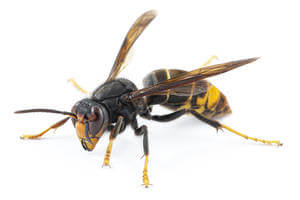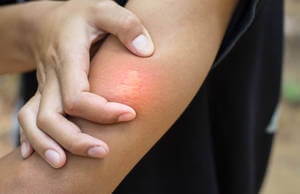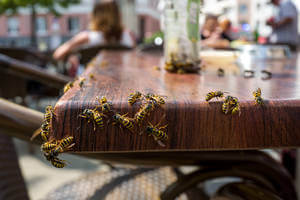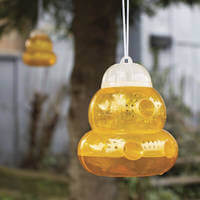In this article, we will discuss how to keep wasps away and discover how a wasp trap works.
We will also learn more about these insects to find out how to eliminate wasps this summer. Specifically, we will discover:
- The most common types of wasps.
- The problems caused by wasps.
- Where wasps build their nests.
- What wasps eat.
- How to keep away wasps. How a wasp trap works
- When to set up a wasp trap
- What attracts wasps. What can be used as a mixture to catch wasps
- Where to place the wasp trap
- Where can I get a wasp trap
What are the most common Types of Wasps?
There are many types of wasps. However, the wasps commonly found are the common wasp and the Asian wasp. Let’s talk a bit more about each of them:

- The common wasp, as its name suggests, is the one that probably comes to mind first when we think of a wasp, with yellow markings.
- The Asian wasp, also known as the killer wasp or velvet wasp, is a species of wasp originally from Asia.
- It is characterized by having a black thorax and abdomen, except for the fourth abdominal segment, which is yellow in color.
- The Asian wasp is an invasive species. Without natural predators, its population grows at a very fast rate. It is the most aggressive wasp that attacks many other beneficial insects.
What Problems Do Wasps Cause?

The main problem is wasp stings. Wasps sting by injecting venom. Unlike bees, which can only sting once and then die, wasps can sting multiple times. It is also common for several wasps to sting at the same time, not just one. Wasp stings are very painful, and some people are allergic to wasp stings, which exacerbates the issue.
That’s why humans have a natural instinct against these insects. If there are wasps lurking in the area, it is almost impossible to enjoy an outdoor meal, a peaceful time by the pool, and we fear for our children to play outside…
In the case of the Asian wasp, the problems it causes are not just stings. As mentioned earlier, the Asian wasp is an invasive species. It feeds on other insects, especially honey bees, which are its preferred food. Bees play an essential role in our ecosystem by pollinating plants. The Asian wasp is also wreaking havoc on many beekeepers, as their bee colonies are greatly affected by this invasive species.
Where Do Wasps Build Their Nests?
Typically, the common wasp builds its nest, called a wasp nest or hive, underground or in cut tree trunks, hollows of houses, and other similar places. Wasp nests can house populations of 20,000 – 25,000 wasps.
However, the Asian wasp, or velvet wasp, builds its nests at a higher elevation. The nests of the velvet wasp resemble large paper balloons hanging from trees or tall structures.
What Do Wasps Eat?

Wasps have a clear preference for sweet foods, such as flower nectar and other sugary substances. They also seek out protein sources, which they usually obtain by consuming other insects.
Understanding their feeding habits is essential when creating bait for a wasp trap, as we will see later.
How to Keep Wasps Away? How Does a Wasp Trap Work?
Here are some tips on how to keep wasps away:
- Do not leave food scraps on the balcony, in the garden, by the pool, etc.
- Use trash cans with lids. Securely close garbage bags.
- Do not leave garbage in the sun or near doors and windows to prevent wasps from entering the house.
- Hang wasp traps with attractive wasp bait inside. Wasp traps are highly effective in reducing the number of wasps in the area, such as the garden, balcony, or pool. You can eliminate hundreds of wasps with just one trap.
- After several days, when the wasp traps are full, empty them, clean them, refill them with wasp bait, and repeat the process.
- If you find a wasp nest on your property, keep a safe distance and consult an expert for its removal.
At BirdGard Iberia, we recommend a very cost-effective wasp trap that delivers excellent results. You can eliminate hundreds of wasps with just one trap:
- It is a relatively small plastic container (13 cm in diameter and 15 cm in height) that you can hang from a tree, post, or any suitable spot on your balcony, terrace, or garden.
- This wasp trap is yellow (a color that seems to attract wasps to the trap).
- It has six funnel-shaped holes positioned in all directions. These holes allow the wasps to enter the trap easily. However, once inside, they cannot find their way out.
- Inside the wasp trap, place wasp bait, then close the lid and hang the trap.
- The wasps will be attracted to the wasp bait, enter through the holes, but once inside, they will be trapped and unable to escape.
Here is a video to show you how this wasp trap works:
When is the Best Time to Place the Wasp Trap?
We all know that there are more wasps in the summer. Therefore, it seems obvious to place the wasp trap during the summer season. While this is true, let’s see why spring is the time to start placing the wasp traps. To understand why, let’s delve into the life cycle of wasps and how wasp colonies are formed:
A wasp colony is primarily composed of the queen wasp and thousands of worker wasps. The queen wasp is the only one capable of reproduction.
Only the queen wasps survive the winter until spring. In spring, with the arrival of good weather and rising temperatures, the queen becomes active, starts laying eggs, building nests, and goes out in search of food for herself and to care for her colony. The worker wasps emerge in early summer and are responsible for feeding the queen. In summer, the queen focuses on enlarging the nest.
Therefore, if we place the wasp traps in spring (March, April, May, June), we can trap the queens and prevent them from building their nests, which would otherwise result in an army of around 20,000 – 25,000 worker wasps settling nearby.
So, if you have had troublesome wasps around your house, pool, garden, during previous summers, don’t wait for the problem to return. Place your wasp trap in spring to try to halt their expansion.
What Attracts Wasps? What Can I Use as a Wasp Bait?
Here are some homemade wasp bait tips that you can make yourself and use in the wasp trap to attract them.
- Wasp Bait “Anti-Wasps – Deluxe”
- Two parts white wine
- Two parts dark/toasted beer
- One part fruit juice (blueberries, oranges, pineapple…) or a tablespoon of honey
- Wasp Bait “Anti-Wasps Teen”
- Cola soda
- Sugar
- Wasp Bait “Anti-Wasps Carnivore”
- Water
- Beer
- Sugar
- Some meat: chicken piece, tip of chorizo sausage…
Where Should I Place the Wasp Trap?
When it comes to placing the wasp trap, we recommend the following:
- Hang it at a height of about 1.5 meters. It’s better not to place it right at ground level.
- If possible, place it away from the area where people will be eating, playing, resting, etc.
- If feasible, hang it next to trees or plants.
What Should I Do If I Want to Get Rid of Wasps But Not Bees?
When using the aforementioned wasp baits, it’s possible that various insects, including non-harmful and less aggressive ones like honeybees, might get trapped. To prevent bees from getting caught in the Wasp Trap, you can impregnate the holes with vinegar. Bees are repelled by the smell of vinegar, but wasps are not affected.
Maintenance of my Wasp Trap
Maintaining the wasp trap is very simple, and it will last you for many seasons:
- Empty the wasp trap when there are many wasps inside.
- Clean the trap just like you would clean any other plastic container.
- Refill the trap with the bait mixture you use for attracting wasps.
- Put the lid back on and hang it again.
Where Can I Get This Wasp Trap?
This wasp trap is available in the BirdGard Iberia online store. Simply add the product to your shopping cart and complete the checkout process. Delivery is very fast. You will receive your wasp trap at your home within one or two days.
